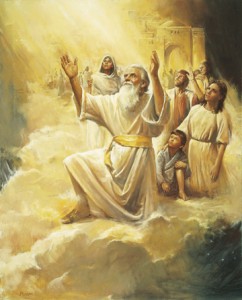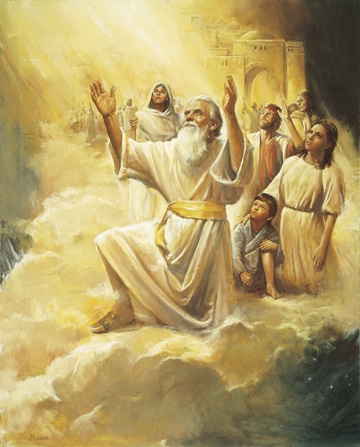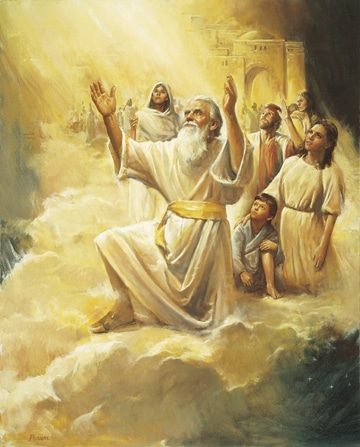Traducción española/Click for Spanish Translation Translation generously provided by Cesar Carreon.

For the teacher
The word “Zion” has many meanings in our vernacular. The original Zion was the city of Enoch, whose citizens were so righteous and pure that they were taken up to God’s bosom without tasting death (translated.) Since then, it is used throughout the scriptures to describe “the pure in heart” or to refer to the Lord’s people. It can mean the state of a person’s heart, and the unity of a community. Early Mormon pioneers used the term “Zion” to refer to the place where they could finally gather together and worship God in peace — eventually Utah. Oddly, there sprung up a retail shop, Zion’s Cooperative Mercantile Inc. (ZCMI), a bank – Zions Bank, and a National Park – Zion National Park, all using Zion in the title. (Whether or not they are the pure in heart, I cannot say.) It is also used in the scriptures to refer to Ancient Jerusalem and “New Jerusalem” (in connection with the second coming of Jesus Christ.)
Because it is a word with so many historical and scriptural occurrences, Young Women might be unclear about the varied definitions. It’s important for the teacher to be able to explain the several uses of the word if they have questions.
Uniquely, the scriptures refer to the word Zion with feminine pronouns (her, she.) Where there aren’t many feminine objects or characters in our scriptures, I think this is worth pointing out to the YW. In my mind, Zion and her attributes are symbolic of our Heavenly Mother so whenever I come across a reference to Zion in the standard works, I mentally replace it with “Heavenly Mother.”
This lesson plan includes something to read, sing, say, hear, touch and do, for a variety of learning styles (aural, visual, tactile & kinesthetic) There is probably enough lesson development/activities to spread this plan over 2 weeks if you like.
Setting up
chalkboard prep, handout sheet and pencils for each girl, small ball of yarn for each girl, optional youtube video to sing along with the Mormon Tabernacle Choir, learn how to finger-knit from this tutorial.
- Set up Chalkboard with these three questions across the top: What is Zion? How can I help build Zion? How do I become pure in heart?
- Sing Hymn 41, Let Zion in Her Beauty Rise, in your opening exercises. (If it’s unfamiliar, sing along with the MoTab in this nice video. or with the interactive church music player)
Teach the doctrine using the scriptures
- As a class, look up Moses 7:18-21. Before reading, ask the following “search” question: “Look and listen for anything that describes Zion. What is Zion?” Invite a volunteer to read the whole passage while others follow along or listen. Invite another girl to volunteer to write responses on the board (people called Zion, one heart, one mind, righteousness, no poor, City of Holiness, safe, blessed, taken up to heaven) as they are found or suggested by the girls.
- Same process for D&C 97:21 (the Pure in Heart)
- If time permits, and if you have a class that likes diving into long passages of scripture, look up 4 Nephi 1:1-5 then skip over to 11-18. Before reading, say this: “Any time we come across a characteristic of Zion, we’re going to stop and list it on the board” (church, repent, baptized, Holy Ghost, no contention, deal justly, all things common, no rich or poor, all free, spiritual gifts, peace, healing, miracles, prosper, build great cities, married, living higher law of Christ, fasting and prayer, love of God in hearts, no envying, no strife, no tumult, no whoredoms, no lyings, no murders, no lasciviousness = sexual purity, HAPPY People!, no crime, lived as children of Christ, heirs to the Kingdom.)
- Reflect and invite discussion about what was read and listed
- How big can Zion be? (the whole human family) How big small can Zion be? (my own heart, my family, our Beehive class, our ward, our school)
- Encourage the Young Women to write their own ideas and or answers from the scriptures on the handout.
Using an object
- Read and analyze Mosiah 18:21 as a class with this search question: “How were the people commanded to behave? How can we build Zion?” (no contention, one eye, one faith, one baptism, hearts knit in unity, love one another) Please point out that having “one eye” means that we are all looking the same direction — to our life with God, not that we all have the same perspective or opinions, “one faith” meaning faith in one Jesus Christ to save us from our sins.
- Start the finger knitting on your hand. Ask, “what does it mean to have our hearts knit together in unity and love?”(Our hearts are interwoven, interdependent on one another.) Speak from the heart describing each girl’s spiritual gifts as you add layers to your finger knitting, “This layer represents Natalie’s heart and the way she builds Zion through her positive attitude and cheerfulness. She practices selfless service when she works at the homeless shelter. This layer represents Susan’s heart and the way she builds Zion in our ward by greeting members as they arrive at Sacrament meeting.” Make enough layers on your finger knitting to show how the stitches interlock. Explain how everyone’s heart is needed, and linked to each other. As you finish up your knitting, invite a Young Woman to read President Oscarson’s quote:
“Though in many ways we are different and unique, we also acknowledge that we are all daughters of the same Heavenly Father, which makes us sisters. We are unified in building the kingdom of God and in the covenants which we have made, no matter what our circumstances… To be sisters implies that there is an unbreakable bond between us. Sisters take care of each other, watch out for each other, comfort each other, and are there for each other through thick and thin. The Lord has said, “I say unto you, be one; and if ye are not one ye are not mine.” Sisterhood: Oh, How We Need Each Other Bonnie L. Oscarson
- Show your length of knitting, then use scissors to snip an internal stitch. Show the class how with even one stitch missing, the knitting unravels. Ask, “How is this like our hearts when even one of us is hurt?” Discuss how to show empathy to those around us.
Activity
- Before class starts, ask one Young woman (or leader) to participate as the person who stands alone. Have the whole class stand. Calmly recite this poem by Edward Markham (with gender replacements): “She drew a circle that shut me out — (have one girl stand alone) Heretic, rebel, a thing to flout, But love and I had the wit to win (everyone else join hands and surround her in a circle) We drew a circle that took her in.”
- If you know your girls are comfortable with this, you can end the poem with a big group hug with all girls in the circle.
Reflective Writing
- Give the girls a minute or two to respond privately on their handout to these questions: “Who do I know that might be feeling shut out? What can I do to draw them in? How will this make my heart more pure?”
- After writing, invite a Young Woman to read Invocation/Benediction aloud to the class as they follow along on their handout.
Optional handout
- Wind a small ball of yarn for each girl (enough to finger knit a short length) with either the poem or Mosiah 18:21 printed out and attached.
Closing
- Zion is The Pure In Heart. Zion is big enough for everyone to bring their hearts, minds, ideas, opinions. To be of “one mind and one heart” does mean that we all hold the same opinions, but that we love one another deeply enough that variety of opinions are welcome and do not threaten our friendship.
- “Make my heart as big as Zion” with room for everyone.
What is Zion Handout
This lesson was originally written in 2015 as Young Women Lesson: What is Zion? (link to lesson outline lds.org)
Lección para las Mujeres Jóvenes en diciembre: ¿Qué es Sión?
La palabra “Sión” tiene muchos significados. La Sión original era una ciudad de habitantes tan justos y puros que fueron llevados hasta el seno de Dios sin probar la muerte (fueron trasladados espiritualmente). Desde entonces, la palabra se utiliza a través de las Escrituras para describir a los “puros de corazón” o para referirse a el pueblo del Señor. Puede significar el estado del corazón de una persona, y la unidad de una comunidad. Los pioneros mormones utilizaron el
término “Sión” para referirse al lugar donde finalmente pudieron reunirse y adorar
a Dios en paz -finalmente Utah. Curiosamente, han surgido una tienda al por menor, (Zion’s Cooperative Mercantile Inc.), un banco (Zion’s bank) y un parque (Zion National Park), todos usando como título el nombre de Sión (si son o no puros de corazón, no puedo decirlo). También se usa en las Escrituras para referirse a la antigua Jerusalén y a la “Nueva Jerusalén “(en relación con la segunda venida de Jesucristo).
Debido a que es una palabra con muchos significados, varias de las mujeres jóvenes podrían no tener bien definidos todos los conceptos. Es importante que la maestra sea capaz de explicar los varios usos de la palabra por si hubiera preguntas.
Casualmente, en las escrituras la palabra Sión aparece con pronombre femenino (ella.) Como no hay muchos objetos o personajes femeninos en nuestras escrituras,
creo que vale la pena señala esto a las MJ. En mi mente, Sión y sus atributos son símbolos de nuestra Madre Celestial, así que cuando me encuentro con una referencia a Sión en los libros canónicos, mentalmente lo reemplazo con “Madre Celestial.”
Este plan de lección incluye algo para leer, cantar, oír, tocar y hacer, para una variedad de estilos de aprendizaje (auditivo, visual, táctil y cenestésico). Probablemente hay suficientes desarrollos de la lección o actividades para difundir este plan más de 2 semanas, si quieres.
Preparación
Preparación de la pizarra, repartir una hoja y lápices para cada niña, una pequeña bola de hilo para cada chica, es opcional el video de YouTube para cantar junto con el Coro del Tabernáculo Mormón. Aprenda cómo tejer con los dedos en este tutorial.
- Escribir en la pizarra las tres preguntas siguientes en la parte superior: ¿Qué es Sión? ¿Cómo puedo ayudar a edificar Sión? ¿Cómo puedo ser pura de corazón?
- Canten el Himno 23 “Bella Sión” en sus ejercicios de apertura (si les es desconocido, pueden cantar junto con el Coro del Tabernáculo en este bonito vídeo
Enseñe la doctrina usando las Escrituras
- Como clase, buscar Moisés 7:18-21. Antes de leer, haga la siguiente pregunta de “búsqueda”: “Presten atención por cualquier cosa que describa Sion. ¿Qué es Sión?”. Invite a una voluntaria para leer todo el pasaje, mientras que las demás leen o escuchan. Invite a otra chica para ser voluntaria para escribir las respuestas en la pizarra (gente que fue llamada “Sión”, uno en corazón, uno en pensamiento, justicia, sin pobres, Ciudad de Santidad, seguridad, bendecida, tomada al cielo) mientras se vayan encontrando o sean sugeridas por las chicas.
- El mismo procedimiento para D & C 97:21 (los puros de corazón)
- Si el tiempo lo permite y si usted tiene una clase que le gusta sumergirse en largos pasajes de escritura, busquen 4 Nefi 1: 1-5, 11-18. Antes de leer, diga esto: “Cada vez que nos encontremos con una característica de Sión, nos vamos a parar y enlistar en el pizarrón”(iglesia, arrepentirse, bautizarse, Espíritu Santo, sin contención, tratar con justicia, todas las cosas en común, sin ricos o pobres, todos libres, dones espirituales, paz, sanidad, milagros, prosperar, construir grandes ciudades, casados, vivir la ley mas alta de Cristo, la oración, el ayuno, el amor de Dios en los corazones, sin envidia, sin lucha, sin alboroto, no hay prostitución, no hay mentiras, no hay asesinatos, sin lascivia = pureza sexual, la gente feliz, ningún crimen, vivir como hijas de Cristo, herederas del Reino.
- Reflexione e invite a la discusión sobre lo que se leyó y lo que se escribió en el pizarrón
- ¿Qué tan grande puede ser Sión? (toda la familia humana)
- ¿Qué tan pequeña puede ser Sión? (mi corazón, mi familia, nuestra clase de Abejitas, nuestro barrio, nuestra escuela)
- Invite a las mujeres jóvenes a escribir sus propias ideas y respuestas de las Escrituras en la hoja que les dio.
Usando un objeto
- Lea y analice Mosíah 18:21 con la clase con esta pregunta clave: “¿Cómo se le mandó a la gente comportarse? ¿Cómo podemos construir Sión?” (Sin contención, un ojo, una fe, un solo bautismo, corazones en unidad, amarnos unos a otros) Por favor, señale que el tener “un ojo” significa que todos estamos en la misma dirección – a nuestra vida con Dios, no que todos tengamos la misma perspectiva u opiniones, “una fe”, que significa la fe en un solo Jesucristo para salvarnos de nuestros pecados.
- Inicie a tejer con los dedos en su mano. Pregunte: “¿qué significa tener nuestros corazones en unidad y amor? “(Nuestros corazones están entrelazados e interdependientes uno de otro) Hable desde el corazón y describa los dones espirituales de cada niña a medida que agregue capas a su tejido. “Esta capa representa el corazón de Natalie y cómo su actitud positiva y alegría fortalece Sión. Ella practica servicio desinteresado cuando trabaja en el refugio para desamparados. Esta capa representa el corazón de Susan y la forma en que construye Sión en nuestro barrio saludando a los miembros a medida que llegan a la reunión sacramental (…)”. Haga suficientes capas en su tejido para mostrar cómo los puntos se entrelazan. Explique cómo se necesita el corazón de todas, y cómo se vinculan entre sí. Mientras termina el tejido, invite a una mujer joven a leer la cita de la presidenta Oscarson: “Aunque en muchos aspectos somos diferentes y únicas, también reconocemos que todas somos hijas de un mismo Padre Celestial, lo que nos hace hermanas. Estamos unidas en la construcción del reino de Dios y en los convenios que hemos hecho, no importa cuales sean nuestras circunstancias… ser hermanas implica que existe un vínculo inquebrantable entre nosotras. Las hermanas se cuidan entre sí, se preocupan una por la otra, se consuelan entre sí y siempre están ahí una para otra en las buenas y en las malas. El Señor ha dicho: “Yo os digo que sean uno; y si no son uno, no sois míos”. ¡Cuánto nos necesitamos unas a otras! Bonnie L. Oscarson.
- Muestre la longitud del tejido de punto, a continuación, utilice tijeras para cortar una costura interna. Muestre a la clase cómo incluso con una puntada que falta, el tejido se deshace. Pregunta: “¿Cómo es esto como nuestros corazones cuando incluso uno de nosotros se lastima?”. Discuta cómo mostrar empatía a los que están a nuestro alrededor.
Actividad
- Antes de comenzar la clase, pida a una mujer joven (o líder) que participe como la persona que está sola. Ponga a toda la clase de pie. Con calma recite este poema de Edward Markham (con reemplazos de género): “Ella dibujó un círculo que me dejó afuera (aparte a una chica). Hereje, rebelde, una cosa para burlarse. Pero el amor y yo tuvimos el ingenio para ganar (todo el mundo se toma de las manos y la rodean en un círculo) Dibujamos un círculo que se la incluyó”.
- Si sabe que sus niñas se sienten cómodas con esto, usted puede terminar el poema con una gran abrazo de grupo con todas las niñas en el círculo.
Redacción reflexiva
- De a las niñas un minuto o dos para responder de forma privada en su hoja estas preguntas: “¿A quién conozco que podrían sentirse excluida? ¿Qué puedo hacer yo para incluirla? ¿Cómo va a hacer esto que mi corazón sea más puro?”
- Después de escribir, invite a una mujer joven a leer “Invocación / Bendición” en voz alta a la clase.
Actividad opcional
- Enrolle una pequeña bola de estambre o lana para cada niña (suficiente para un tejido de longitud corta) ya sea con el poema o con Mosíah 18:21 impresa y amarrada.
Cierre
- Sión son los puros de corazón. Sión es lo suficientemente grande para que todo el mundo la lleve a sus corazones, mentes, ideas, opiniones. Ser de “una sola mente y un solo corazón” no quiere decir que todos tenemos las mismas opiniones, sino que nos amemos unos a otros con tanta fuerza que esa variedad de opiniones sean bienvenidas y no amenacen nuestra amistad.
- “Hacer mi corazón tan grande como Sión” con espacio para todos y todas.





